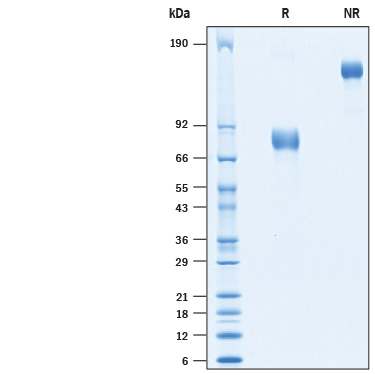Recombinant Human uPAR Fc Chimera Protein, CF Summary
Product Specifications
When Recombinant Human uPAR Fc Chimera (Catalog # 10378-UK) is immobilized at 1 µg/mL (100 µL/well), Recombinant Human u-Plasminogen Activator (uPA)/Urokinase (Catalog # 1310-SE) binds with an ED50 of 2-16 ng/mL.
| Human uPAR (Leu23-Arg303) Accession # Q03405.1 | IEGRMD | Human IgG1 (Pro100-Lys330) |
| N-terminus | C-terminus | |
Analysis
Product Datasheets
Carrier Free
CF stands for Carrier Free (CF). We typically add Bovine Serum Albumin (BSA) as a carrier protein to our recombinant proteins. Adding a carrier protein enhances protein stability, increases shelf-life, and allows the recombinant protein to be stored at a more dilute concentration. The carrier free version does not contain BSA.
In general, we advise purchasing the recombinant protein with BSA for use in cell or tissue culture, or as an ELISA standard. In contrast, the carrier free protein is recommended for applications, in which the presence of BSA could interfere.
10378-UK
| Formulation | Lyophilized from a 0.2 μm filtered solution in PBS. |
| Reconstitution | Reconstitute at 500 μg/mL in PBS. |
| Shipping | The product is shipped at ambient temperature. Upon receipt, store it immediately at the temperature recommended below. |
| Stability & Storage: | Use a manual defrost freezer and avoid repeated freeze-thaw cycles.
|
Scientific Data
 View Larger
View Larger
When Recombinant Human uPAR Fc Chimera (Catalog # 10378-UK) is immobilized at 1 µg/mL (100 µL/well), Recombinant Human u-Plasminogen Activator/Urokinase (Catalog # 1310-SE) binds with an ED50 of 2-16 ng/mL.
 View Larger
View Larger
2 μg/lane of Recombinant Human uPAR Fc Chimera (Catalog # 10378-UK) was resolved with SDS-PAGE under reducing (R) and non-reducing (NR) conditions and visualized by Coomassie® Blue staining, showing bands at 74-85 kDa and 150- 170 kDa, respectively.
Reconstitution Calculator
Background: uPAR
uPAR (urokinase-type plasminogen activator receptor, also known as CD87), is a cell surface receptor that binds urokinase-type plasminogen activator (uPA) which cleaves the zymogen plasminogen to form the active enzyme plasmin. uPAR expression is activated during inflammation, immune responses, and conditions of tissue remodeling and wound healing (1). Human uPAR is synthesized as a 335 amino acid (aa) residue precursor protein with a 22 aa signal peptide. Removal of the C-terminal propeptide generates a fully processed uPAR containing 283 aa with five potential N-linked glycosylation sites and a C-terminal GPI-anchor site (2). Variants due to alternative splicing of uPAR also exist (3). Human and mouse uPAR share approximately 60% aa sequence identity and the receptor-ligand interaction is strictly species-specific (4). The uPA/uPAR interaction initiates signal transduction responses resulting in activation of protein tyrosine kinases, gene expression, cell adhesion, and chemotaxis. uPAR can interact with integrins to suppress normal integrin adhesive function and promote adhesion to vitronectin through a high affinity vitronectin binding site on uPAR. uPAR is considered as a biomarker in many inflammatory diseases including cancer, cardiovascular diseases, chronic kidney diseases and diabetes (5).
- Smith, H.W. and C.J. Marshall (2010) Nat. Rev. Mol. Cell Biol. 11:23.
- Ploug, M. et al. (1991) J. Biol. Chem. 266:1926.
- Dear, A.E. and R.L. Medcalf (1998) Eur. J. Biochemistry 252:185.
- Ellis, V. et al. (1992) Ann. N.Y. Acad. Sci. 667:13.
- Desmedt, S. et al. (2017) Crit. Rev. Clin. Lab. Sci. 54:117.
FAQs
No product specific FAQs exist for this product, however you may
View all Proteins and Enzyme FAQsReviews for Recombinant Human uPAR Fc Chimera Protein, CF
There are currently no reviews for this product. Be the first to review Recombinant Human uPAR Fc Chimera Protein, CF and earn rewards!
Have you used Recombinant Human uPAR Fc Chimera Protein, CF?
Submit a review and receive an Amazon gift card.
$25/€18/£15/$25CAN/¥75 Yuan/¥2500 Yen for a review with an image
$10/€7/£6/$10 CAD/¥70 Yuan/¥1110 Yen for a review without an image
